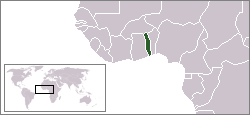| Revision as of 22:20, 6 March 2004 editWik (talk | contribs)21,748 editsmNo edit summary← Previous edit | Revision as of 09:11, 7 March 2004 edit undoMorwen (talk | contribs)Administrators56,993 edits link flagNext edit → | ||
| Line 3: | Line 3: | ||
| <tr><td style="background:#efefef;" align="center" colspan="2"> | <tr><td style="background:#efefef;" align="center" colspan="2"> | ||
| <table border="0" cellpadding="2" cellspacing="0"> | <table border="0" cellpadding="2" cellspacing="0"> | ||
| <tr><td align="center" width="130px">] ]</td></tr> | <tr><td align="center" width="130px">] | ||
| <td align="center" width="130px">]</td></tr> | |||
| <tr><td align=center>(]) | |||
| </table></td></tr> | </table></td></tr> | ||
| <tr><td align="center" colspan=2 style="border-bottom:3px solid gray;"><font size="-1">''National ]: Travail, Liberté, Patrie<br>(Work, Liberty, Homeland)''</font></td></tr> | <tr><td align="center" colspan=2 style="border-bottom:3px solid gray;"><font size="-1">''National ]: Travail, Liberté, Patrie<br>(Work, Liberty, Homeland)''</font></td></tr> | ||
Revision as of 09:11, 7 March 2004
| ||||
| National motto: Travail, Liberté, Patrie (Work, Liberty, Homeland) | ||||
 | ||||
| Official language | French | |||
| Capital | Lomé | |||
| President | Gnassingbe Eyadema | |||
| Prime minister | Koffi Sama | |||
| Area - Total - % water | Ranked 122nd 56,785 km² 4.2 | |||
| Population
- Density | Ranked 106th
88/km² | |||
| Independence
- Date | From France
1960 | |||
| Currency | CFAF | |||
| Time zone | UTC +0 | |||
| National anthem | Salut à toi, pays de nos aïeux (Hail to thee, land of our forefathers) | |||
| Internet TLD | .tg | |||
| Calling Code | 228 | |||
The Republic of Togo is a small country in West Africa, bordering Ghana and Benin at its sides, and Burkina Faso at its back. It has a small Atlantic Ocean coast, on which the capital Lomé is located.
History
Main Article: History of Togo
Togo was until 1918 a German colony. French Togoland became Togo in 1960 after the expiration of the French-administered UN trusteeship on April 27 of that year. Despite the facade of multiparty rule instituted in the early 1990s, the government continues to be dominated by the military, which has maintained its power almost continuously since 1967. The first president of Togo, Sylvanus Olympio (1901-1963) took office as soon as Togo gained independence in 1960. When he refused to let 626 Togolese veterans of the French army, many of whom had fought in Indochina and Algeria, join Togo's army, they deposed him in a military coup on January 13, 1963. He was killed the next day. A civilian president, Nicolas Grunitzky (1913-1969) was installed, but exactly four years later, there was another military coup. Grunitzky fled the country and was killed in a car crash in the Ivory Coast. One of the original veterans from the 1963 coup, Gnassingbe Eyadema (1937-) has been president since 1967. He was nearly defeated in the 1998 election by Gilcrest Olympio, son of Sylvanus Olympio. Eyadema was reelected again in 2003.
Geography
Main article: Geography of Togo
Togo is located in Western Africa. It borders the Bight of Benin in the south. Ghana lies to the west, Benin to the east. To the north Togo is bound by Burkina Faso.
In the north there is gently rolling savannah. in the centre of the country there are hills. The south of Togo is characterized by a plateau which reaches to a coastal plain with extensive lagoons and marshes in the south.
Economy
Main article: Economy of Togo
This small sub-Saharan economy is heavily dependent on both commercial and subsistence agriculture, which provides employment for 65% of the labor force. Cocoa, coffee, and cotton together generate about 30% of export earnings. Togo is self-sufficient in basic foodstuffs when harvests are normal, with occasional regional supply difficulties. In the industrial sector, phosphate mining is by far the most important activity, although it has suffered from the collapse of world phosphate prices and increased foreign competition.
Map of TogoMap of Togo
Togo serves as a regional commercial and trade center. The government's decade-long effort, supported by the World Bank and the IMF, to implement economic reform measures, encourage foreign investment, and bring revenues in line with expenditures has stalled. Political unrest, including private and public sector strikes throughout 1992 and 1993, jeopardized the reform program, shrunk the tax base, and disrupted vital economic activity. The 12 January 1994 devaluation of the currency by 50% provided an important impetus to renewed structural adjustment; these efforts were facilitated by the end of strife in 1994 and a return to overt political calm. Progress depends on following through on privatization, increased openness in government financial operations (to accommodate increased social service outlays), and possible downsizing of the military, on which the regime has depended to stay in place. Lack of aid, along with depressed cocoa prices, generated a 1% fall in GDP in 1998, with growth resuming in 1999. Assuming no deterioration of the political atmosphere, growth should rise to 5% a year in 2000 - 2001.
Culture
Main article: Culture of Togo
See also: Music of Togo, List of writers from Togo
See Also
- Politics of Togo
- Demographics of Togo
- Communications in Togo
- Transportation in Togo
- Military of Togo
- Foreign relations of Togo
- List of cities in Togo
- List of former German colonies
- Mostly from the CIA World Factbook 2000.